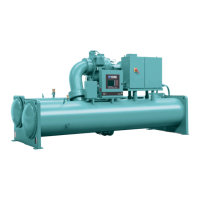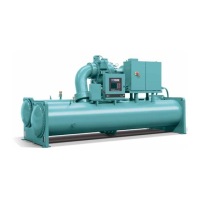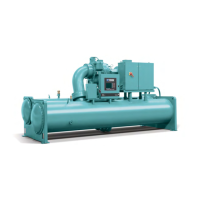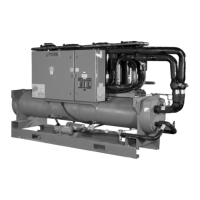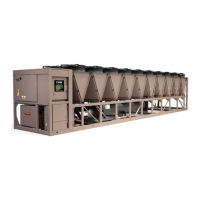FORM 160.77-O2
ISSUE DATE: 11/15/2011
SECTION 1 - YKEP CHILLER OVERVIEW
JOHNSON CONTROLS
15
1
ANTI-SURGE, PRV
Keeping the compressor out of surge is the function
of the anti-surge subsystem. The anti-surge system is
based on a straight-line approximation of the compres-
sor surge curve (Figure 6 on Page 15).
The anti-surge line is biased to the right of the actual
surge line. When the compressor needs to move left on
the map, and move less mass flow, the vanes can only
be reduced so far, before a lack of mass flow causes
a surge condition. The anti-surge system supplements
mass flow to the compressor by using the Hot Gas By-
pass valve. This allows the chiller to be unloaded with-
out surge.
Once the anti-surge system has been set for the maxi-
mum head condition, and the minimum head condi-
tion, the compressor is restricted from surge. The point
represented by the intersection of VPD1 and MVP1 is
the worst case operating condition of the compressor,
with high head and low load. The other condition that
defines the anti-surge line is at low head and low load,
represented by the intersection of VPD2 and MVP2.
The shaded area of the left side of the map is the surge
area.
The vanes cannot close more than a given percentage
for a given head condition, defined by this line. As the
capacity control system unloads the chiller, the Hot
Gas Bypass valve is opened proportionally to maintain
stable operation and control the process.
H
E
A
D
200
150
100
50
0
0 25 50 75 100
MVP2 MVP1
% VANES
VPD1
x
VPD2
FIGURE 6 - SYSTEM ANTI-SURGE MAP
LD15231
Anti-Surge (PRV) Calculation
The anti-surge tuning values are based on estimated
part load conditions and minimum vane signals re-
quired at these conditions to prevent unstable opera-
tion (surging):
Compressor
Differential
(Head) Pressure
Minimum PRV Signal
Setpoint for
Stable Operation
High Head
(PD1)
70 psid MVP1 = 8% Open
Low Head
(PD2)
30 psid MVP2 = 2% Open
It is very important that this control be
adjusted to suit chiller operating condi-
tions to achieve maximum efciency of
operation.
Anti-Surge (PRV) Tuning
• With the chiller running in automatic, take the
condensing conditions to the highest inlet tem-
perature attainable in the system (without tripping
on high discharge pressure). Increase tower inlet
temperature or reduce tower ow.
• At the highest condensing temperature, start re-
ducing the load on the chiller, by reducing the
ow, or decreasing the inlet temperature. This
will cause the capacity control system to back the
vanes in an unload sequence.
• If the chiller surges before the Hot Gas valve be-
gins to open, then the anti-surge line must move
right on the map.
• If the chiller never surges down to minimum load,
then the anti-surge parameters are adequate for
protection, but may not be most efcient.
• During the unload sequence, record the operating
head as VPD1.
• Increasing and decreasing the parameter MVP1
will move the anti-surge line right and left on the
map. Listen for a surge, and move the anti-surge
line right several percent, to increase refrigerant
ow, by supplementing hot gas.
• Repeat the procedure for low head operation.
• At the lowest condensing temperature, start reduc-
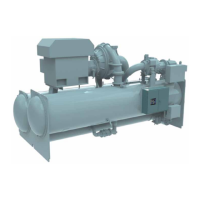
